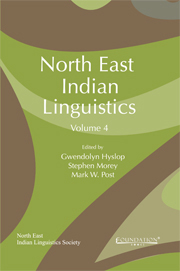Book contents
- Frontmatter
- Contents
- About the Contributors
- Foreword
- A Note from the Editors
- History, Contact and Evolution
- 1 On the Origins of Bodo-Garo
- 2 The Stammbaum of Boro-Garo
- 3 Variation in the Order of Modification in Tai Ahom: An Indication of Historical Boro-Garo Influence?
- 4 The Nominalizing Velar Prefix *gV- in Tibeto-Burman Languages of Northeast India
- Bodo-Garo Grammar
- Orthography, Poetics and Text
- New Descriptions
- Classifiers
- Eastern Indo-Aryan Grammar
- Austroasiatic
3 - Variation in the Order of Modification in Tai Ahom: An Indication of Historical Boro-Garo Influence?
from History, Contact and Evolution
Published online by Cambridge University Press: 05 May 2013
- Frontmatter
- Contents
- About the Contributors
- Foreword
- A Note from the Editors
- History, Contact and Evolution
- 1 On the Origins of Bodo-Garo
- 2 The Stammbaum of Boro-Garo
- 3 Variation in the Order of Modification in Tai Ahom: An Indication of Historical Boro-Garo Influence?
- 4 The Nominalizing Velar Prefix *gV- in Tibeto-Burman Languages of Northeast India
- Bodo-Garo Grammar
- Orthography, Poetics and Text
- New Descriptions
- Classifiers
- Eastern Indo-Aryan Grammar
- Austroasiatic
Summary
Introduction
Typically in Tai languages the head precedes the modifier. As Morey says, “The noun phrase in the Tai languages is a strongly head initial structure”. He adds, “if there is more than one modifier in an NP, the most unmarked order appears to be – Noun > Adjective > Possessor > Classifier > Relative Clause > Demonstrative. Though there are no examples in the corpus of texts showing all of the possible modifiers.” (Morey 2005: 259) This order of modification is attested in the Tai Ahom language, spoken during the Ahom kingdom that ruled in Assam in the period 1228-1824. This unmarked order is found in Ahom manuscripts; however, some variant orders are also found.
We begin the paper with a brief history of Ahom which is discussed in section 2. In section 3, I provide the source of manuscripts used for the study and, in section 4, I discuss briefly about modification process in general. Following it, in section 5, I present an outline of the linguistic features of Ahom, and move on to discuss modification at a language-particular level in section 6. Section 6.1 deals with different kinds of modifiers. With this we turn in section 7 to a survey of the unmarked order of constituents and subsequently look at modification order of expressives in section 7.1. The next two sub-sections, i.e. 7.1.1 and 7.1.2 explore the functions of expressives as modifiers and as intensifiers.
- Type
- Chapter
- Information
- North East Indian Linguistics , pp. 36 - 57Publisher: Foundation BooksPrint publication year: 2012



